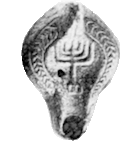
For thousands of years small oil lamps were used for light in homes, temples, taverns, and tombs. At least as far back as 3,500 BC, oil lamps are known to have been in use, though crude by standards reached in the first few centuries AD. Oil may have been used as a light source even further back, in naturally cupped stone containers, and later, in Mesopotamia, in sea-shells.
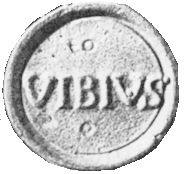
Another well known Jewish oil lamp style is called the Darom, after a region in the Hebron Hills where it originated. Shortly after
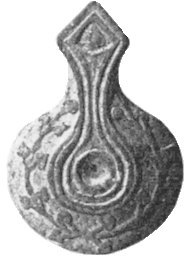
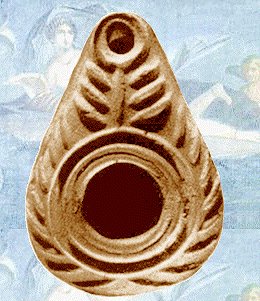
Many other examples are known which depict items associated with Jewish holidays., or the Festival of Tabernacles, often was represented with a palm leaf or branch on oil lamps. Palms, or fig trees, were also connected with, or the Festival of First Fruits. This festival featured seven produce items; figs, wheat, barley, grapes, olives, pomegranates, and honey. Symbols of all of these appeared on, or Passover, was also represented on the lamps, usually through a depiction of unleavened bread, or sheaves of grain.
At the same time that these almond shaped lamps were in use in the Middle East, in the Mediterranean, North Africa had become a major production center for oil lamps. Tunisia and Carthage were especially noted for their red-ware lamps, which were exported all over the Holy Roman Empire. Unlike the Jewish lamps seen above, these Christian lamps of the 5th and 6th Centuries often depicted animals and humans, and even Jesus and the Saints. Others used the popular Christogram, a Greek letter monogram for Christ. Many other North African lamps featured animals, with some of the older Roman trends reappearing, such as running lions and birds, but now with altered symbolic significance. Fish, an obvious Christian motif, were also popular, as were pictures of saints. Not all lamps were religiously decorated, however. Scenes with soldiers, fighting animals, and other more secular activities were also common place. Few lamps by this period, though, had erotic scenes, such as could be found on a few in earlier Roman times.
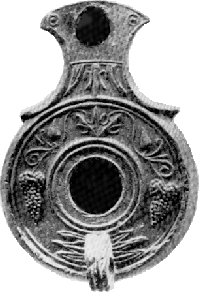

From the evolution of the saucer lamps, pottery lamps came to be made with enclosed bodies. The Greeks were among the most prolific of the early lamp makers of these styles. They still continued to throw the lamp bodies on a potters wheel, but then hand attached spouts and handles. Another innovation they utilized was glaze, which slowed the inevitable seepage of oil into the porous clay body. Most Greek lamps were glazed black or dark greens, but a few other colours are also known to have been used. The black-glazed Greek lamp at the left was found in Southern Italy, and dates to the 4th Century BC.
The common use of pottery containers for oil lamps, however, was not to flourish until perhaps the 8th or 7th centuries BC. At first, pottery lamps were simple wheel-thrown saucers. The wick, often of flax, was immersed in the oil and draped on the saucers rim. In most areas, olive oil was the favoured fuel, but other vegetable oils and even animal fats could be used as well. Before long, potters discovered forming a small spout on the saucer helped keep the wick in place, and soon after the sides of the saucer were simply folded up while the piece was still moist, to create an even better wick support. The lamp at the right, from Israel, shows this feature, and dates to about the 8th century BC.
Yet another lamp of this type features an inscription on the shoulders of the lamp body. Mostly written in debased Greek, the major theme of the sayings were all the same, to the effect of May the Light of Christ shine well for you. Other variations were written, but most all use this theme of light and Christ together, a powerful symbol of the light in the darkness, and the Light of the word of God. Many of these lamps were produced in the Christian areas of Palestine, and imported to Jerusalem and other areas of Christian Israel.
A few makers gained such a name for their wares, that even their stamp was copied by others throughout the Empire. One such name often found copied was FORTIS, though numerous others were also pirated in this way. Perhaps more common than forged names on lamps, however, were district offices. That is large lamp makers in Rome or elsewhere may have opened authorized lamp production centers in the Provinces who bore their trade-mark name on the lamp. This was a marketing strategy that often followed the Roman Army into areas that had created new markets for their products. Besides utilizing local craftsmen, some lamp specialists may have migrated as well, to set up the sub-contract lamp making operations.
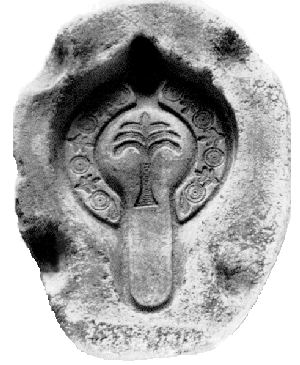
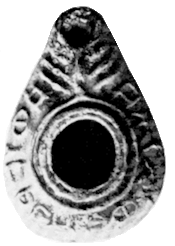
or used floral and geometric designs as seen below. The Herodian lamp, still made by a mix of wheel and hand work until the at least the 1st Century AD, when some began to use moulds as well. While popularly called a Herodian lamp, the use of this style extended well before and after the reign of Herod the Great and Herod Agrippa for they are known from sites dating to between the 1st Century BC and the 2nd Century AD. These were, incidentally, perhaps the most common style of lamp in use in Judea during the ministry of Jesus.
Clay and plaster moulds, unlike stone moulds, could be formed by covering an archetype, or lamp model, such as the one above. This archetype, from Athens, is solid fired clay, and dates to the 1st Century BC. A two piece mould could be made using clay or plaster, and then the archetype saved to use again if those moulds broke or wore out. Normally, notches were made in one side of the mould so that when its mate was cast, the two halves would align perfectly. Such notches can be seen in a North African or Tunisian mould, dating to about AD 400-500. One of the advantages to using plaster for moulds, was that once it dried, further decoration could easily be carved, something difficult to do with clay. The use of moulds also allowed for more ornate decoration to be put onto lamps, or even for the creation of three dimensional lamps in figures such as a helmet (like some found at Pompeii), a human or animal head, or even an entire figure of an animal or humans body. Highly ornate or figural lamps were often associated with temple offerings more than domestic lighting use, but some more wealthy patrons used them in their homes.
Clay is easily moulded, and this fact was not lost upon the lamp makers. During the Hellenistic Age, lamp moulds came into widespread use. By the 1st Century BC, moulded lamps were as common as wheel-thrown lamps in most parts of the ancient world. Moulds could be made of stone, clay, or plaster. Stone moulds had to be labouriously hand carved out of a soft rock, such as limestone, but once completed, would last many years. Lamps were not slip cast, that is created from a liquid clay mixture, but rather were press moulded, where the clay is rolled into a sheet, and hand pressed into the mould, and then the two halves pressed together. After a drying period, the lamp could be removed, trimmed and pierced, and put with others to be fired in the kilns later on.
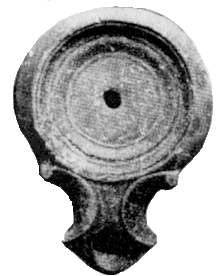
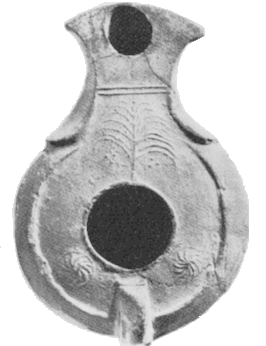
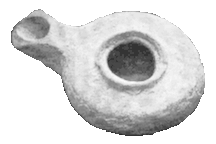
the Roman army destroyed the Second Temple in Jerusalem, refugees from that city fled the occupation and settled in this region. It is at this time that they developed this new style, which lasted from about AD 70 to the end of the Bar-Kokhba Revolt, in AD 135. These lamps followed the basic outline of the Herodian lamp, but the body was flatter, and they were made exclusively in moulds. Most were decorated with symmetrical designs. A large number depicted items with significant religious or cultural meaning. The grapes on the example at the left, for instance, are probably representative of a golden grape cluster which was at the Temple before the Roman invasion.
While highly decorated lamps were popular, and a cheap source of art for even the humblest of homes, undecorated lamps were also made in huge quantities. These are referred to asor Factory lamps as they were mass produced, typically in larger cities. The lamp at the left is one such example, from Rome and of a style common about AD 25 to AD 75. Many of these factory lamps had a makers stamp on the bottom of them, produced by making the name in the mould, so that it stood out on the lamp when pressed.
(its also been widely plagiarized on the net)
It probably dates to sometime in the 60s AD.
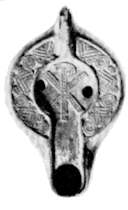
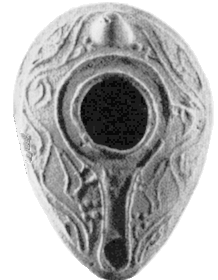
The same basic body style used on the candlestick Byzantine period lamps survived in the Middle East well into the following Islamic period. Returning to the Mosaic tradition of avoiding depictions with living beings, the Islamic period lamps once again were ornamented primarily with geometric and floral designs. These lamps were found throughout the area from about AD 600 to AD 900, though in some areas the style survived for several more centuries. Examples found in Caesarea, with this basic body design, but coated with a green glaze, were used into the Crusader period, and are dated to about AD 1200.
Other lamps were left undecorated, or the decoration was limited in the subject matter, for religious reasons. In Israel, for example, it was customary for locally produced lamps to avoid any representation of a human or other living creature. Instead, they either retained very plain lamps, such as the Herodian lamp seen here,
The other handy aspect of making plaster or clay moulds, was that less skilled craftsmen could easily produce well executed lamps by simply making his own mould off of a lamp he obtained from elsewhere. This copying of lamps was a widespread practice, and it can often be seen by lining up lamps of the exact same design. Those which were moulded from a copy are smaller due to clay shrinkage as they dried, and their decoration is often less crisp than the original. Provincial lamp makers found this practice an easy way to keep up with popular lamp styles being produced elsewhere.
is found on what are usually called candlestick lamps. These appear in early Byzantine times, around the 5th or 6th Centuries AD. Others believe this style is an abstract palm branch. In either case, there is clear evidence that this style of lamp was very popular among Jews and Christians alike. Variants of this lamp style sometimes substitute a cross near the nozzle, and was especially popular in the Jerusalem area. Large groups of these and the candlestick lamps have been found in tombs, left where they were last burning, as the doors were sealed.
This brief introduction to lamps is naturally simplistic, but serves as an overview of a ceramic tradition that lasted for centuries.
Objects of special iconographic significance were also featured on the lamps. The Ark of the Covenant appears on some lamps, as does thewas a seven-branched candelabrum in the Temple, and is described in detail in the Book of Exodus (25:31-40). The representation of aon an oil lamp in this period was rather rare though. It was not until the following centuries that it became more commonplace. This is probably a reflection of the prohibition of making a replica of thein the Temple, and so many of the early versions made theirdepictions with a different number of branches. By the 4th Century AD, this restriction had relaxed somewhat, and seven branchedappear more frequently. The example shown here is North African, probably from Atripalda.
The background to this page is from a wall mural at Pompeii in the House of Venus, known as the Floating Venus.
In the centuries that saw the decline of the use of clay oil lamps, wheel made versions made a significant comeback. Glass and metal lamps also began to rise in popularity again, and eventually the clay lamps lost the importance they had once played in the daily lives of ancient people.